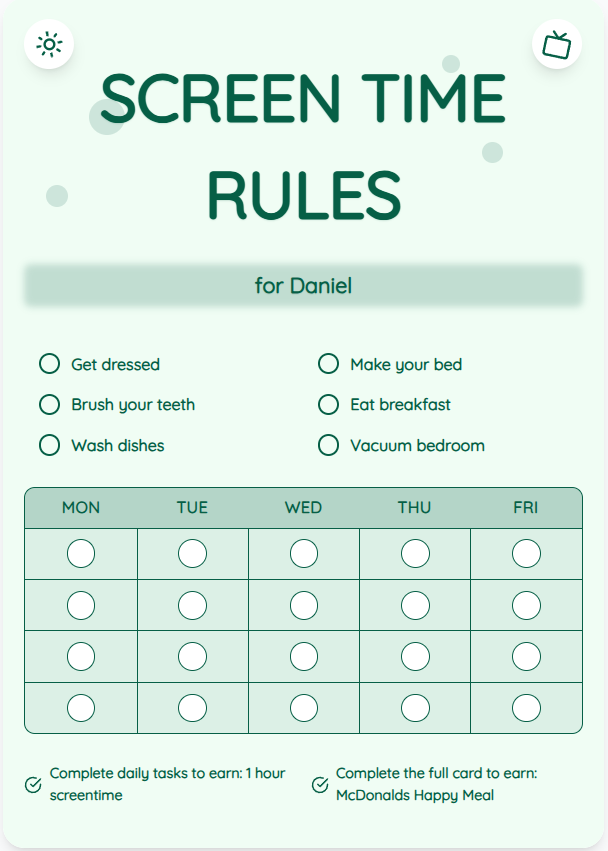Understanding Screen Time Limits for Children
As a parent, you may wonder, 'What does screen time limit mean?' Understanding the significance of setting boundaries on screen time is crucial for your child's development and well-being. Let's dive into practical strategies to manage screen time effectively.
See What Your Screen Time Chart Will Look Like
Here's an example of a beautiful, customizable screen time rules chart you can create for your family

The Importance of Screen Time Limits
Setting screen time limits refers to establishing boundaries on the amount of time children spend using digital devices such as smartphones, tablets, computers, and TVs. Excessive screen time can have negative effects on children's physical health, mental well-being, and social skills. By implementing appropriate screen time rules, parents can promote a balanced lifestyle for their children.
Practical Tips for Managing Screen Time
1. Create a screen time schedule: Establish specific times when screen time is allowed and when it is off-limits. 2. Use screen time charts: Utilize visual aids like screen time charts to help children understand and adhere to the set limits. 3. Encourage alternative activities: Promote physical play, reading, and creative hobbies as alternatives to screen time. 4. Lead by example: Set a positive role model by managing your own screen time effectively.
Put These Tips Into Action
Create a custom chart to implement these strategies with your child
FAQs about Screen Time Limits
1. What is the recommended daily screen time for children? - The American Academy of Pediatrics suggests limiting screen time to 1-2 hours per day for children aged 2-5. For older children, consistent limits should be in place based on individual needs. 2. How can I enforce screen time limits without conflicts? - Communicate openly with your child about the reasons behind screen time rules and involve them in setting limits collaboratively. Consistency and positive reinforcement are key to successful enforcement. 3. Are there benefits to screen time limits? - Setting screen time limits can foster healthier habits, improve sleep quality, enhance academic performance, and strengthen family relationships.
Practical Tips for Success
- Establish a screen-free zone in your home, such as the dining area or bedrooms.
- Use parental control features on devices to monitor and restrict screen time.
- Engage in tech-free activities as a family, such as outdoor outings or game nights.
Frequently Asked Questions
What is the impact of excessive screen time on children?
Excessive screen time has been linked to issues such as obesity, sleep disturbances, academic challenges, and social behavior problems in children.
How can I motivate my child to reduce screen time?
Offer incentives for reducing screen time, such as earning extra playtime outdoors or choosing a family activity as a reward for limiting screen usage.
Should I completely ban screen time for my child?
While complete bans may not be practical or necessary, moderation and balance are key. It's essential to monitor and regulate screen time based on your child's age, interests, and overall well-being.
By understanding the importance of screen time limits and implementing practical strategies, you can create a healthy digital environment for your child. Visit ScreenTimeRules.com to explore customizable screen time charts that simplify managing your child's screen time effectively.
Ready to Transform Your Family's Screen Time?
Join thousands of parents who have successfully managed screen time with our customizable charts.
